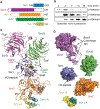Crystal Structure of the COMPASS H3K4 Methyltransferase Catalytic Module
- PMID: 30100181
- PMCID: PMC6108940
- DOI: 10.1016/j.cell.2018.06.038
Crystal Structure of the COMPASS H3K4 Methyltransferase Catalytic Module
Abstract
The SET1/MLL family of histone methyltransferases is conserved in eukaryotes and regulates transcription by catalyzing histone H3K4 mono-, di-, and tri-methylation. These enzymes form a common five-subunit catalytic core whose assembly is critical for their basal and regulated enzymatic activities through unknown mechanisms. Here, we present the crystal structure of the intact yeast COMPASS histone methyltransferase catalytic module consisting of Swd1, Swd3, Bre2, Sdc1, and Set1. The complex is organized by Swd1, whose conserved C-terminal tail not only nucleates Swd3 and a Bre2-Sdc1 subcomplex, but also joins Set1 to construct a regulatory pocket next to the catalytic site. This inter-subunit pocket is targeted by a previously unrecognized enzyme-modulating motif in Swd3 and features a doorstop-style mechanism dictating substrate selectivity among SET1/MLL family members. By spatially mapping the functional components of COMPASS, our results provide a structural framework for understanding the multifaceted functions and regulation of the H3K4 methyltransferase family.
Keywords: COMPASS; H3K4 methylation; MLL; Set1; chromatin; epigenetics; methyltransferases; structural biology.
Published by Elsevier Inc.
Conflict of interest statement
DECLARATION OF INTERESTS
The authors declare no competing interests.
Figures






Similar articles
-
A conserved interaction between the SDI domain of Bre2 and the Dpy-30 domain of Sdc1 is required for histone methylation and gene expression.J Biol Chem. 2010 Jan 1;285(1):595-607. doi: 10.1074/jbc.M109.042697. Epub 2009 Nov 6. J Biol Chem. 2010. PMID: 19897479 Free PMC article.
-
Structure and Conformational Dynamics of a COMPASS Histone H3K4 Methyltransferase Complex.Cell. 2018 Aug 23;174(5):1117-1126.e12. doi: 10.1016/j.cell.2018.07.020. Epub 2018 Aug 9. Cell. 2018. PMID: 30100186 Free PMC article.
-
Charge-based interaction conserved within histone H3 lysine 4 (H3K4) methyltransferase complexes is needed for protein stability, histone methylation, and gene expression.J Biol Chem. 2012 Jan 20;287(4):2652-65. doi: 10.1074/jbc.M111.280867. Epub 2011 Dec 6. J Biol Chem. 2012. PMID: 22147691 Free PMC article.
-
Diverse and dynamic forms of gene regulation by the S. cerevisiae histone methyltransferase Set1.Curr Genet. 2023 Jun;69(2-3):91-114. doi: 10.1007/s00294-023-01265-3. Epub 2023 Mar 31. Curr Genet. 2023. PMID: 37000206 Review.
-
The Core Complex of Yeast COMPASS and Human Mixed-Lineage Leukemia (MLL), Structure, Function, and Recognition of the Nucleosome.Subcell Biochem. 2024;104:101-117. doi: 10.1007/978-3-031-58843-3_6. Subcell Biochem. 2024. PMID: 38963485 Review.
Cited by
-
Mechanism of Cross-talk between H2B Ubiquitination and H3 Methylation by Dot1L.Cell. 2019 Mar 7;176(6):1490-1501.e12. doi: 10.1016/j.cell.2019.02.002. Epub 2019 Feb 11. Cell. 2019. PMID: 30765112 Free PMC article.
-
The Chemical Biology of Reversible Lysine Post-translational Modifications.Cell Chem Biol. 2020 Aug 20;27(8):953-969. doi: 10.1016/j.chembiol.2020.07.002. Epub 2020 Jul 21. Cell Chem Biol. 2020. PMID: 32698016 Free PMC article. Review.
-
Sharing Marks: H3K4 Methylation and H2B Ubiquitination as Features of Meiotic Recombination and Transcription.Int J Mol Sci. 2020 Jun 25;21(12):4510. doi: 10.3390/ijms21124510. Int J Mol Sci. 2020. PMID: 32630409 Free PMC article. Review.
-
The semisynthesis of site-specifically modified histones and histone-based probes of chromatin-modifying enzymes.Methods. 2023 Jul;215:28-37. doi: 10.1016/j.ymeth.2023.05.004. Epub 2023 May 26. Methods. 2023. PMID: 37244506 Free PMC article.
-
RNA binding induces an allosteric switch in Cyp33 to repress MLL1-mediated transcription.Sci Adv. 2023 Apr 21;9(16):eadf5330. doi: 10.1126/sciadv.adf5330. Epub 2023 Apr 19. Sci Adv. 2023. PMID: 37075125 Free PMC article.
References
-
- Allis CD, Caparros M-L, Jenuwein T, and Reinberg D (2015). Epigenetics (Cold Spring Harbor Laboratory Press; ).
-
- Avdic V, Zhang P, Lanouette S, Groulx A, Tremblay V, Brunzelle J, and Couture J-F (2011). Structural and Biochemical Insights into MLL1 Core Complex Assembly. Structure 19, 101–108. - PubMed
-
- Briggs SD, Xiao T, Sun Z-W, Caldwell JA, Shabanowitz J, Hunt DF, Allis CD, and Strahl BD (2002). Gene silencing: Trans-histone regulatory pathway in chromatin. Nature 418, 498. - PubMed
Publication types
MeSH terms
Substances
Grants and funding
LinkOut - more resources
Full Text Sources
Other Literature Sources
Molecular Biology Databases
Miscellaneous

